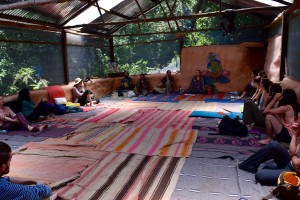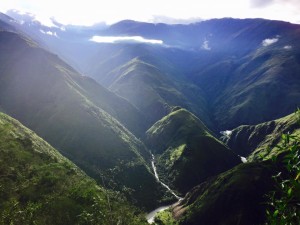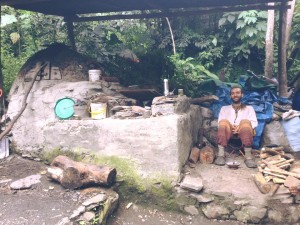5 Permaculture Design Principles & Your Inner Landscape
posted by Anthony Bossler on April 12th, 2016
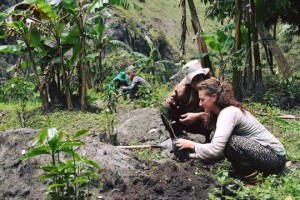 What does Shamanic Permaculture mean to you? It can draw up so many stories or expectations. Especially for anyone experienced in permaculture design principles, it can be tough to maintain beginner’s mind.
What does Shamanic Permaculture mean to you? It can draw up so many stories or expectations. Especially for anyone experienced in permaculture design principles, it can be tough to maintain beginner’s mind.
But, by letting go of expectation and preconceived ideas, we can truly observe and learn to engage in a two-way conversation with the greater organism that is Mother Nature, and ultimately, the universe.
A core principle Paititi works with is observing and interacting with the outer landscapes, simultaneously seeing how those interactions also apply to our inner landscape; evolving our consciousness and developing ever deeper awareness as a result. Just how deep this connection is always takes us by surprise.
There were certainly a few expectations at the start of our recent Shamanic Permaculture Work Study Service Session. But it wasn’t long before permaculture design principles began to shape our inner landscapes, and the shamanic component was in full swing.
1. Creatively respond to change
What do you do when things happen that don’t meet your expectations? The permaculture principle of creatively responding to change is great for staying on track and discovering effective solutions.
At such a remote location like the section of the Amazon watershed that Paititi stewards in Peru, getting the right materials at the right time isn’t always possible. As for the weather at the tail-end of rainy season in the subtropical mountain region? You can imagine how it goes. When expectations didn’t manifest, our team responded to the changes admirably.
The shift in seasons represent another change that needs to happen in our gardens. Also in-line with the permaculture design principle “observe and interact”, rain season means it’s time to build channels to bring life-giving water to our vegetables.
Watching the water flowing to nourish the soil also makes us reflect on the inner journey and consider how we can unblock energetic/emotional channels in our lives and allow mother nature’s life force to freely flow inwardly, too.
2. Store energy effectively & use biodiversity
During the day, we dig and unblock irrigation channels for the garden and in the cool evenings, we turn our focus to the energetic work needed internally. Permaculture states that energy should be harnessed and stored efficiently. If energetic channels are blocked, action is required.
This brings up the permaculture design principle of biodiversity. The diverse healing skillset of the team helps us with the energetic work. Participants have backgrounds in healing modalities including shiatsu massage, reiki, essential oil therapy and breathwork.
When it rains heavily, our plans to cultivate the outside are sometimes dashed and we must creatively respond to that change, too. Which is another way of saying that we all take the day off, doing qigong, yoga and getting shiatsu massages from each other.
Shamanic permaculture isn’t all about hard physical work after all =)
With massage, breathwork, acupressure and the other skill sets of the team, breakthroughs happen. People begin to realize old habits and thought patterns they’d been clinging to for years, holding them back and stopping them from flourishing.
It is a beautiful transformation of inner and outer landscapes.
3. Use edges and value the marginal
Another great permaculture principle is to “use edges and value the marginal”. That means the transition zones between areas, or those untended places in the corners that we’d rather pretend don’t exist. Tangled and messy, it’s easier just to ignore them.
However, those very spots might be the perfect environment to grow something special. Yet only by facing our edges in this way can we ever hope to discover the true potential exploring them might hold.
The coming in during the retreat, and people can definitely meet some inner edges. It gets hot, there are more bugs, the work may physically demanding, and all at a relatively high altitude.
Still, by pushing through those edges, much growth takes place. Horizons expand, strength is cultivated, and greater potential in everyone is discovered.
4. Obtain a yield
We must obtain yields not just to sustain, but also to regenerate. We build on the work done by those before us. When we apply this permaculture design principle, we contribute spiritual and ecological regeneration from a shared heart so that growth happens, inner and outer.
The previous retreat was Embodying True Nature. And the Shamanic Permaculture team definitely harvested the spiritual fruits of those before, inspiring us to consider what seeds we want to plant for those that come after.
It’s relevant on a more immediate community level, too. We can see how the seeds we sow produce aspects of light and shadow that get reflected in the group.
For example, if someone aggravates you in a conversation, how you react plants a seed. Without compassion, perhaps showing a less-than-patient attitude, that seed of your reaction can easily grow into something more serious that needs addressing later.
Seeds are sown with every interaction, internally and externally. Only by cultivating presence to sow seeds consciously and with due care can we hope for a positive yield and regenerative results.
5. Produce no waste
Waste is responsible for many of the world’s problems, which is why this permaculture principle is so important. Composting is the perfect example.
We use several different methods at Paititi, from hot compost to traditional bin-and-flip, to dry-composting toilets, to employing our delicious prehistoric friends, the chickens, to help break stuff down.
Good things grow from waste. And the lotus flower is an excellent symbolic example. The “undesirable” waste, swamp, mud (or even sometimes poop) and the beauty that flourishes from it are the same. There is no lotus flower without the mud. One cannot exist without the other. They are essentially the same whole, just like a thriving garden and its compost.
Anyone who’s worked through tough times and grown as a result can probably relate to this idea. And, just like composting, some mud can be worked through faster than other mud. Some composting require less attention, some are quicker fixes than others, but they all have their ability to produce beauty in the end. So why waste anything?
Just like the difference between a regular daily sweaty work in the garden, a monthly shiatsu massage and a deep, or an intense one-night session with mother ayahuasca. Working through all that mud surely culminates in sustainable healing.
From those realizations we contemplate how we can compost what doesn’t serve us and turn those challenges into seeds of growth that can nourish our beings and truly produce no waste!
It’s all here if we’re willing to work with it. And it’s the same with the consciousness transformation on the inner landscape level. At any time we can look inwardly and set the intention to plant a more positive seeds with our next human interaction (yes, especially if that interaction has to be with our own mother…)
What is shamanic permaculture?
Slowly (or instantaneously) but surely, things start to take shape in Paitit’s home, Larapata.
As we move and interact with the weather, environment, and each other from that state of heart-centered presence, we can weave between the inner and outer landscapes through life’s changing seasons to truly be of benefit to all. And that’s what shamanic permaculture is all about.
Inspired to join us in the journey?
We have a number of Shamanic Permaculture programs yet to come this year including a month-long immersive Permaculture Design Certification Course (PDC).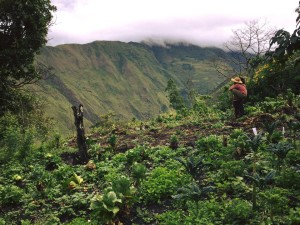
In the PDC, we’ll have the opportunity to engage in the full 72 hour Permaculture curriculum with the addition of much hands-on experience along side inner transformation work:

